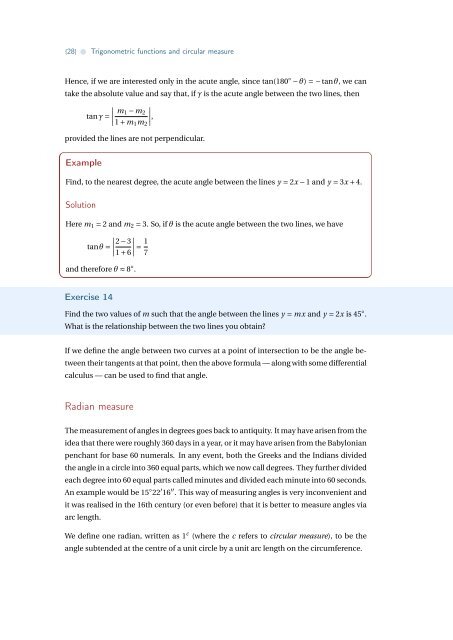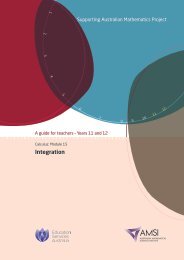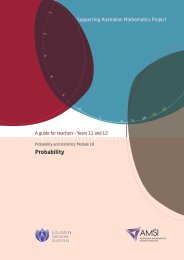Trigonometric functions and circular measure - the Australian ...
Trigonometric functions and circular measure - the Australian ...
Trigonometric functions and circular measure - the Australian ...
- No tags were found...
Create successful ePaper yourself
Turn your PDF publications into a flip-book with our unique Google optimized e-Paper software.
{28} • <strong>Trigonometric</strong> <strong>functions</strong> <strong>and</strong> <strong>circular</strong> <strong>measure</strong>Hence, if we are interested only in <strong>the</strong> acute angle, since tan(180 ◦ − θ) = −tanθ, we cantake <strong>the</strong> absolute value <strong>and</strong> say that, if γ is <strong>the</strong> acute angle between <strong>the</strong> two lines, <strong>the</strong>n∣ tanγ =m 1 − m 2 ∣∣∣∣,1 + m 1 m 2provided <strong>the</strong> lines are not perpendicular.ExampleFind, to <strong>the</strong> nearest degree, <strong>the</strong> acute angle between <strong>the</strong> lines y = 2x − 1 <strong>and</strong> y = 3x + 4.SolutionHere m 1 = 2 <strong>and</strong> m 2 = 3. So, if θ is <strong>the</strong> acute angle between <strong>the</strong> two lines, we havetanθ =2 − 3∣1 + 6∣ = 1 7<strong>and</strong> <strong>the</strong>refore θ ≈ 8 ◦ .Exercise 14Find <strong>the</strong> two values of m such that <strong>the</strong> angle between <strong>the</strong> lines y = mx <strong>and</strong> y = 2x is 45 ◦ .What is <strong>the</strong> relationship between <strong>the</strong> two lines you obtain?If we define <strong>the</strong> angle between two curves at a point of intersection to be <strong>the</strong> angle between<strong>the</strong>ir tangents at that point, <strong>the</strong>n <strong>the</strong> above formula — along with some differentialcalculus — can be used to find that angle.Radian <strong>measure</strong>The <strong>measure</strong>ment of angles in degrees goes back to antiquity. It may have arisen from <strong>the</strong>idea that <strong>the</strong>re were roughly 360 days in a year, or it may have arisen from <strong>the</strong> Babylonianpenchant for base 60 numerals. In any event, both <strong>the</strong> Greeks <strong>and</strong> <strong>the</strong> Indians divided<strong>the</strong> angle in a circle into 360 equal parts, which we now call degrees. They fur<strong>the</strong>r dividedeach degree into 60 equal parts called minutes <strong>and</strong> divided each minute into 60 seconds.An example would be 15 ◦ 22 ′ 16 ′′ . This way of measuring angles is very inconvenient <strong>and</strong>it was realised in <strong>the</strong> 16th century (or even before) that it is better to <strong>measure</strong> angles viaarc length.We define one radian, written as 1 c (where <strong>the</strong> c refers to <strong>circular</strong> <strong>measure</strong>), to be <strong>the</strong>angle subtended at <strong>the</strong> centre of a unit circle by a unit arc length on <strong>the</strong> circumference.
















